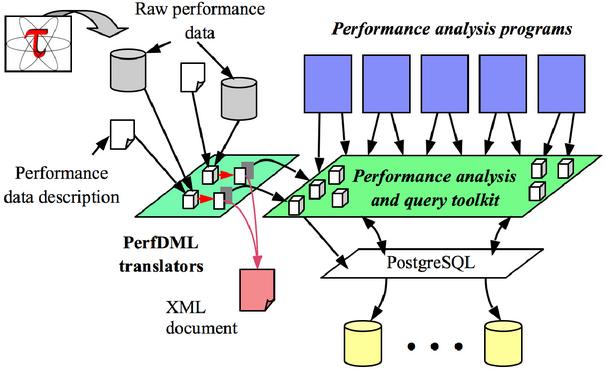


Next: Conclusions
Up: paper-final
Previous: Large-Scale Performance Monitoring and
Empirical performance evaluation of parallel and distributed systems
often generates significant amounts of performance data and analysis
results from multiple experiments as performance is being investigated
and problems diagnosed. Yet, despite the broad utility of
cross-experiment performance analysis, most current performance tools
support performance analysis for only a single application
execution. We believe this is due primarily to a lack of tools for
performance data management. Hence, there is a strong motivation to
develop performance database technology that can provide a common
foundation for performance data storage and access. Such technology
could offer standard solutions for how to represent the performance
data, how to store them in a manageable way, how to interface with the
database in a portable manner, and how to provide performance
information services to a broad set of analysis tools and users. A
performance database system built on this technology could serve both
as a core module in a performance measurement and analysis system, as
well as a central repository of performance information contributed to
and shared by several groups.
To address the performance data management problem, we designed the
Performance DataBase Framework (PerfDBF) architecture shown in Figure
5. The PerfDBF architecture separates the framework into three
components: performance data input, database storage, database query
and analysis. The performance data is organized in a hierarchy of
applications, experiments, and trials. Application
performance studies are seen as constituting a set of experiments,
each representing a set of associated performance measurements. A
trial is a measurement instance of an experiment. We designed a
Performance Data Meta Language (PerfDML) and PerfDML translators to
make it possible to convert raw performance data into the PerfDB
internal storage. The Performance DataBase (PerfDB) is structured
with respect to the application/experiment/trial hierarchy. An
object-relational DBMS is specified to provide a standard SQL
interface for performance information query. A Performance DataBase
Toolkit (PerfDBT) provides commonly used query and analysis utilities
for interfacing performance analysis tools.

Figure 5: TAU performance database framework
To evaluate the PerfDBF architecture, we developed a prototype for the
TAU performance system for parallel performance profiles. The
prototype PerfDBF converts the raw profiles to PerfDML form, which is
realized using XML technology. Database input tools read the PerfDML
documents and store the performance profile information in the
database. Analysis tools then utilize the PerfDB interface to perform
intra-trial, inter-trial, and cross-experiment query and analysis. To
demonstrate the usefulness of the PerfDBF, we have developed a
scalability analysis tool. Given a set of experiment trials,
representing execution of a program across varying numbers of
processors, the tool can compute scalability statistics for every
routine for every performance metric. As an extension of this work,
we are applying the PerfDBF prototype in a performance regression
testing system to track performance changes during software
development.
The main purpose of the PerfDBF work is to fill a gap in parallel
performance technology that will make it possible for performance
tools to interoperate. The PPerfDB [8] and Aksum
[6] projects have demonstrated the benefit of providing such
technology support and we have hopes to merge our efforts. We already
see benefits within the TAU toolset. Our parallel performance
profile, ParaProf, is able to read profiles that are stored in
PerfDBF. In general, we believe the key will be to find common
representations of performance data and database interfaces that can
be adopted as the lingua franca among performance information
producers and consumers. Its implementation will be an important
enabling step forward in performance tool research.



Next: Conclusions
Up: paper-final
Previous: Large-Scale Performance Monitoring and
Sameer Suresh Shende
2003-02-21

